“Your mission, should you choose to accept it, is to find the recipe for perfect bores…your instructions are to produce bores that are perfectly straight and round. This message will self-destruct after five minutes. Good luck.”
Although it’s not “Mission: Impossible,” good bore geometry is critical in order to achieve proper ring sealing. Bore distortion prevents the rings from conforming to the cylinder walls and allows oil and combustion gases to get by the piston rings producing blowby. Proper bore geometry is especially important for high performance engines that produce higher temperatures and cylinder pressures.
Experts on cylinder honing procedures say that you need to know what your goal is before you select abrasives for your project. You need to know what type of surface you want and what recommendations your ring supplier requires.
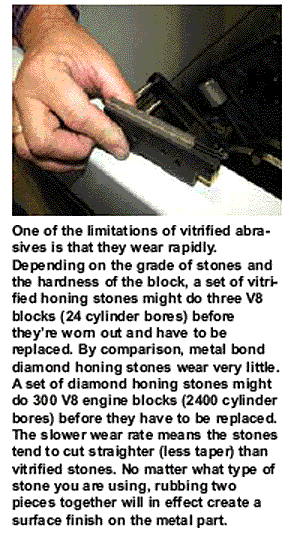
Reduced friction and improved sealing is the goal when it comes to achieving the proper cylinder bore finish. Too rough and your finish will grind the rings and create enough friction to stop a jumbo jet. Too smooth and you run the risk of oil sliding down the walls faster than a 5-year-old at a water park. Of course there’s much more to it but the basic idea to arriving at the best cylinder bore surface finish is the same: reduce friction and improve bore geometry at whatever costs.
Some of the latest bore finish developments include hot honing processes that simulate engine temperatures at operating conditions as well as the simulated clamp load from the cylinder head being torqued in place. Another process used by some engine builders is tapered or profiled bores that counteract bore distortions under load. And at the high-end there are processes like etched cylinders and dry-film lubricants used to enhance lubrication in the areas that need it most. There’s some interesting work being done with laser honing also, a process which has been around a while but still seems to be a mystery to many. Some have thought a laser was used to cut the bores, but that’s not the case: pockets are instead cut into the bore to hold oil in high wear areas.
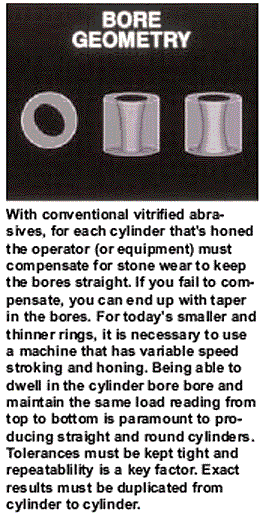
Piston ring manufacturers are intricately involved with surface finish requirements for cylinder bores and the various types of ring materials and coatings that work best. The key is to achieve the right balance of smoothness and oil support. According to one piston ring expert, cylinder wear virtually stops when the rings are properly seated in the bore. When a thin film of oil supports the rings they no longer make any contact with the cylinder wall. This assumes, of course, that the rings conform to the cylinder bores and the surface finish is adequate enough.
Another trend that has affected surface finish requirements has been driven by the OEMs. For the past decade, vehicle manufacturers have been moving toward smaller, lighter piston rings to reduce friction. And both OEM and performance rings have evolved in similar ways mainly to improve performance and lower emissions as well.
Bore geometry
To exactly measure true bore geometry, experts say, you must use what is called a PAT gauge (inner contour meter). However this equipment is expensive, ranging anywhere from $150,000 to $175,000 so it’s usually out of the question for the average shop. And the question needs to be asked: does the average shop really need one anyway? No, say experts, because equipment manufacturers use one first to develop their tooling. Part of what you’re buying is the testing that has already been done. The bore geometry homework is done for you. Manufacturers know, through tooling design, why the stone is where it is in relation to the bore. The spacing has already been developed and how much abrasive you need to achieve a certain result is all done based on tests they do to measure bore distortion. In a sense it’s like GM or anyone else doing tests on parts before you buy them, says one expert.
According to one expert, when you measure straightness and roundenss in a cylinder individually with a dial bore gauge, you’ll get a different number than when you measure the bore’s cylindricity, which is looking at straightness and roundness together. In fact, it may be a large difference. If you check something that may be .002″ straight and round with a dial bore, it may be .005″ when you check cylindricity. The problem is when you have certain shapes in the bore – squareness and lobe shapes – you won’t pick those up with a dial bore gauge.
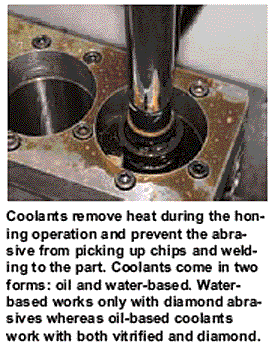
Bore distortion
Lobing can be the result of several things, including how the honing tool is designed, where the abrasives are spread out and how much abrasive there is. According to experts, these are very real factors on bore geometry. Torque plates are another thing that can affect distortion. Experts say the way the bolts are spaced can create mechanical distortion. So you can get mechanical distortions based on torque plates, however, experts agree that torque plates are still good to use.
Many of today’s engines are being designed so they move the distortion in the bores from out of the ring travel area. So you see more engines with longer head bolts today, and the bolts are located lower in engine cases. With this design you’re still going to get distortion but engine designers are moving it out of the most important area; the ring belt area. It’s very costly for engine manufacturers if they have to use a torque plate on every engine. So if the manufacturers can move distortion down to the bottom where it really doesn’t do any harm, then it’s much better and less expensive to produce. MLS gaskets will also minimize bore distortion. So if there’s an MLS gasket available experts say it’s a good idea to use it for that very reason.
These are some of the things from the OE level that have trickled into performance and also helped to minimize bore distortion in those areas.
Surface finish
Surface finish is one of those issues that often has a lot of different requirements put upon it from the manufacturers or remanufacturers for the specifications they are looking for. However, equipment manufacturers say that they simply provide “recipes” for these requirements. What you need for a specific job depends on what you’re trying to accomplish, say equipment experts. That’s what dictates what type of surface finish you need, and what type of abrasives you need to select.
For instance, Nickel Ceramic (known by its trademarked name Nikasil) cylinders have a tendency to produce a very smooth surface finish. It doesn’t need to have a plateau finish with a certain valley depth like a cast iron surface needs to have because it has the ability to retain oil by itself. So you need to adjust your method of operation when you’re planning to prepare that type of a surface. And Nikasil definitely takes diamonds to cut because of how hard the material is. It’s not a material that you get in and pull out large amounts of material. It’s really meant for a fine honing process. There’s only a certain depth to the plating process in the bore anyway so you can’t take much out without going through it. The best way to approach it, say skilled surfacing experts, is to treat it gently, don’t leave too deep of valleys and make it as smooth as possible.
No matter what type of machine tool you use, it creates a roughness pattern on the machined part. Machining to produce a desired surface finish can be thought of in a couple of ways: one is that the ideal finish is a function of speed and the physical geometry of the cutting tool you choose for the job. It is the best you can hope to achieve with the speed and tool you are using. This ideal finish can only be reached if chatter and movements in the machine tool itself are eliminated.
Diamonds/vitrified abrasives
Diamonds are not just for your wife or girlfriend, diamonds can also be for engine builders.
You should typically use a fine grit diamond for materials such as Nickel Ceramic, depending on how much material you have to remove. Experts say the most you should remove with Nickel Ceramic is about .010″, which would be considered a large amount.
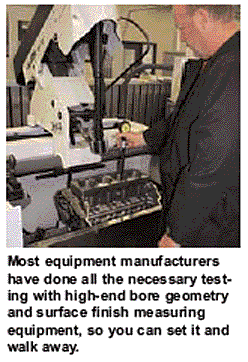
Some experts say that diamond abrasives are taking over from conventional abrasives in shops, but it varies on how much. According to one equipment manufacturer about 60 percent or more are conventional abrasive users and the rest are diamond users. Yet, others say it’s closer to the other way around.
One way you can look at the differences is that conventional vitrified abrasives give you a little more freedom to use different types of stones for different jobs without having to make a bigger initial investment in diamonds.
You’re basically buying a diamond for a particular process, and you’re buying all your abrasives up front. With conventional abrasives you’re buying them on an as needed basis so it allows you to switch to different types of abrasives a little more freely.
Experts say that when choosing abrasives you have to make a decision on what you’re going to be doing. If you do a lot of the same engines or bore sizes then diamond is the way to go. One manufacturer says a lot of diamond is sold to racing engine builders because many of them are doing the same size bore all the time, which makes sense. These customers don’t see a Honda one day and a Big Block Chevy the next. So be careful to make the right investment for a certain application. Look at whether the investment will likely pay off for your shop’s type of operation.
Once you have the process down for a particular engine and you’re going to do this process over and over again. You can realize some real advantages with diamond. Diamond tools are really well suited for this because they’re more consistent and hold their shape much longer than conventional stones. So you have repeatability. Even though manufacturers hold their abrasives to very close tolerances, the superabrasives are less operator dependent.
Some race teams have said that they are getting the same finish as they were when they first bought the superabrasive. So you get the same consistency and it’s great for repeatable processes.
Now, if you decide to change that process and, say, go with a rougher finish, it may cost you because you’ll need a new superabrasive.
Can you get too smooth? It depends on the application, say experts. Typically the smoothest you can get with cast iron materials is about 3 to 5 microinches Ra. That’s about as smooth as you can get the texture. There are some racing applications where teams are getting the cylinders that smooth. The only way to get to that level of smoothness is with diamonds. If you want something with a deeper valley and a low Rpk and deep Rvk, you can produce that same finish with diamond too. It might take a different step process to do it but you can achieve it with diamond.
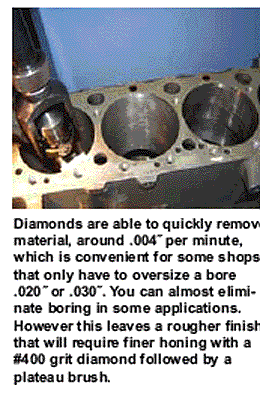
Plateau finish
If you compare a freshly honed cylinder bore to a worn out bore, there is quite a difference. A worn cylinder bore will have a mirror-like quality to it because most of the peaks have been worn down and the valleys that retain oil may not be as deep.
Years ago, piston rings were expected to perform the final finish operation on a cylinder bore. Cylinders were honed to the correct size and then rings were set and engine fired. After the initial break-in period, the rings would have knocked off all the peaks and made a nice smooth path to ride on.
This is an outdated concept today as most ring manufacturers and OEMs require a much smoother surface to begin with, and most piston rings come pre-lapped and ready to go. Plateau finishes virtually mimic the break-in period and eliminate much of the wear and tear on the rings and cylinder surface. Experts agree that once the rings have seated there is almost no wear since there is proper bearing surface to support the ring on a film of oil.
As honing equipment and tooling has become more precise and user friendly, and as manufacturers have reduced tolerances overall, surface finish requirements have become ever more important. Errors in producing the correct surface will surely have implications to the bottom line.













